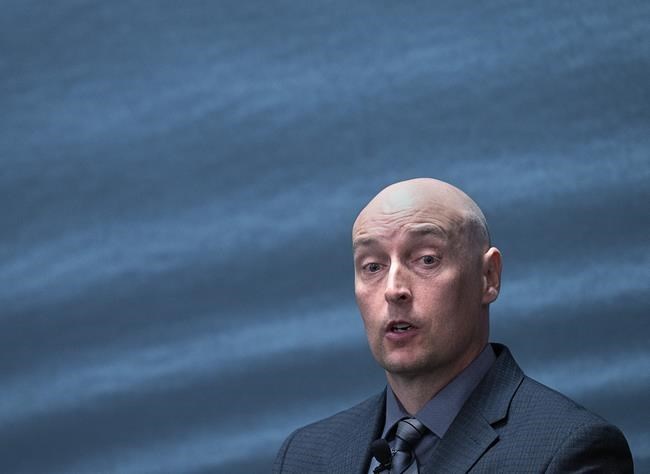TRURO, N.S. — A police chief testified Monday that during the 2020 Nova Scotia mass shooting, he wasn't asked by the RCMP to send officers, though they were trained in responding to active shooters and were among the closest to the rampage.
Chief Dave MacNeil of the Truro Police Service told a public inquiry that the normal protocol for the Mounties in the nearby detachment would have been to request help before he dispatched any of his 36 officers.
Three Truro officers were on duty on the night of April 18 when the shootings started at about 10 p.m. in Portapique, 40 kilometres to the west. But MacNeil told a commission lawyer that as the killer in a replica police car continued his murders over 13 hours, the RCMP didn't ask him to provide personnel.
The inquiry has heard that four Mounties from the Colchester division, the rural county surrounding Truro, were the first to respond to the initial shootings in Portapique, and by the time backup arrived from other RCMP detachments at about 10:45 p.m., the killer had escaped out a back road.
MacNeil testified that if his force had been asked, he would "definitely” have called in officers as needed. He said they were trained in responding to active shooter scenarios, had carbines in their cars and were trained to use them.
The lawyer for the inquiry also asked MacNeil about having just three people on duty rather than the normal five, and MacNeil responded this was due to a COVID-19 policy aimed at reducing staff exposure to the virus. However, he added, "we could have very easily had more people in" if requested by the RCMP.
The veteran chief also said that when he reached out to RCMP Chief Supt. Chris Leather at 9:50 a.m. on April 19 to offer assistance, Leather emailed back saying, "It sounds like we may (have) the suspect pinned down in Wentworth. Will be in touch." In fact, the gunman was not pinned down, and in the next half-hour he would drive through Truro undetected.
According to a summary provided by a public inquiry on Monday, the gunman entered the town at about 10:11 a.m. and was gone nine minutes later, passing within blocks of two local officers. It says officers had received descriptions over an hour before then of what to watch out for.
The summary notes that Cpl. Edwin Cormier of the Truro Police Service was on duty at that point, overseeing constables Dan Taylor, Jason Reeves and Thomas Whidden.
It also says RCMP Staff Sgt. Bruce Briers had contacted Cormier to inform him the killer was in "a fully marked, newer model ... looks like a Ford," replica RCMP vehicle. By then, the call number on the side of the car had also been circulated.
At 8:51 a.m., Cormier radioed all the constables on his shift and updated them on the information he had received. One of the officers said in an interview with the inquiry last month he was "unnerved" at the prospect of encountering the replica vehicle.
"I had his face (from a photo), but at the time I'm like, 'That's not good enough,'" Taylor said. "I felt like whoever it was could probably get the drop on me unless I had my gun pointed at every cruiser that came in the parking lot."
During cross-examination, the lawyer for the union representing RCMP members asked MacNeil why a senior officer wasn't called in the early hours of April 19 after police received three "Be On the Lookout" notices warning that an armed and dangerous suspect had been involved in an active shooting.
National Police Federation lawyer Nasha Nijhawan said the RCMP notices provided "a lot of information," but MacNeil replied that the notices didn't tell Truro police what danger existed for the town itself. He took exception to the lawyer's suggestion that Truro should have been better prepared.
He said there had to be "a lot of catastrophic failures" for the gunman, Gabriel Wortman, to be able to get to Truro from the scene of three of his killings that morning in Wentworth. "For you to suggest today that we should have this (lockdown) in place, yeah, great, in hindsight, but there had to be a lot of things go wrong for this guy to get from Wentworth to Truro.”
An RCMP dispatcher did eventually phone Truro police asking that they lock down the town, but by that time, Wortman had already passed through and was on his way toward Halifax.
Audio transcripts indicate confusion from Truro police over what the lockdown request meant. "Uh, when you say shut down, what do you mean?" Cormier asks.
"Well I don’t know if you need, uh, maybe you can do some, some roadblocks on the main," RCMP dispatch supervisor Kristen Baglee replies.
Truro police Insp. Darrin Smith also spoke with Baglee, who confirmed that the replica police vehicle in a photo distributed earlier was loaded with weapons.
She then mentioned, as she had to Cormier, that the gunman also could be driving a white Ford pickup truck that had been seen leaving the Glenholme, N.S., area. "That’s one of the vehicles that hasn’t been located that’s associated to him," Baglee told Smith. Smith radioed the information to all Truro police members.
In an interview with the inquiry, Smith expressed his bewilderment with the RCMP's information and request to lock down. He said he thought at the time that the response wasn’t co-ordinated and that the request was made out of "panic" and the need to "just do something."
"It was all over the board, all over the map so to speak," Smith said.
This report by The Canadian Press was first published June 6, 2022.
— With files from Keith Doucette and Lyndsay Armstrong in Halifax
Michael Tutton, The Canadian Press

